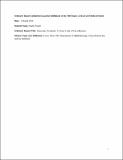| dc.description.abstract | Purpose: The health and economic impacts of non-adherence to glaucoma treatment are profound. If adherence were increased, even marginally, the occurrence of severe complications such as blindness may be reduced. This study sought to understand which factors contribute to glaucoma patients’ failure to properly take their medication and elicit how these reasons can be remedied.
Methods: Patients from a single physician’s clinic, who had both a diagnosis of glaucoma and a prescription for one or more pressure-lowering eye drops, comprised the eligible population. These patients were recruited from a convenience sample in the waiting room. Patients who consented to participate (99 patients of 121 patients approached, or 82%) took a written paper survey, which asked patients questions about their medication taking habits, their technology usage, and their preferred medication-reminder methods. Independent sample t tests and chi square tests were performed to find correlations between variables isolated from the surveys.
Results: 99 patients completed surveys. For the survey question, “Do you take your medicated eye drops at approximately the same time (within an hour) every day?” 86 of 95 respondents (91%) replied in the affirmative. There was a statistically significant difference (p= .04611) observed between the mean ages of those who responded yes (67 years old) and no (55 years old). This indicates that older patients tend to take their medication closer to the same time every day than do younger patients. Interestingly, a similar correlation between reported number of missed doses and age was not seen. According to the survey, those who take their medication within the same hour every day tend to use many medication-reminder methods - friends, family, and written notes - in addition to themselves to remember their medication. Meanwhile, those who take their medication less consistently during the day used fewer medication-reminder methods - mainly their spouses. At this time, there appears to be no statistically significant correlation between a patient’s “tech-savviness” and his/her self-reported level of adherence.
Conclusions: Patients who take their medications at consistently the same time every day tended to be older and used many medication-reminder methods compared to patients who take their medications less consistently. Better knowledge of the role of technology, reminders, and timing habits as they are related to adherence is integral to improving patient adherence - and thus health - overall. | |


